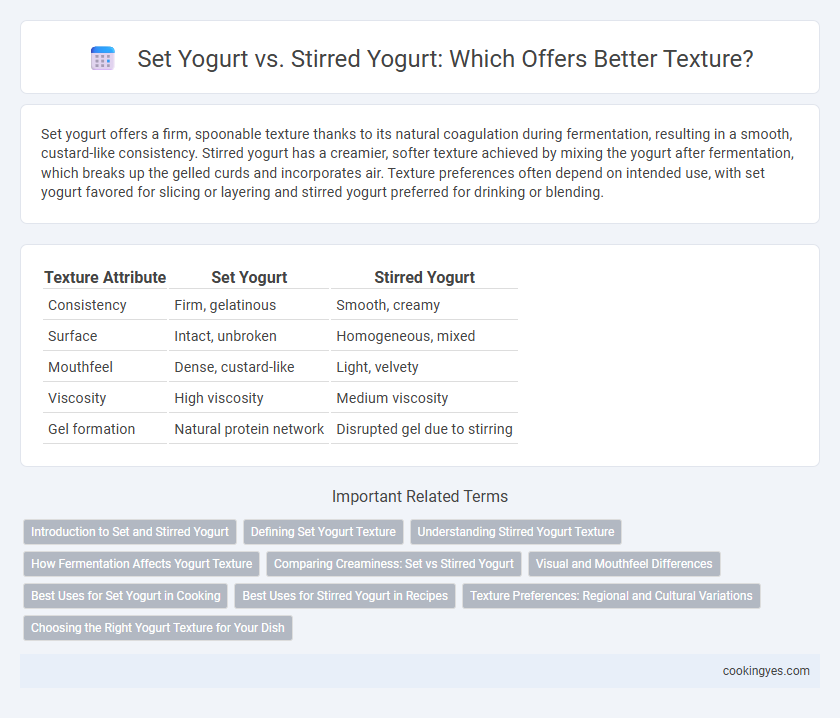Set yogurt offers a firm, spoonable texture thanks to its natural coagulation during fermentation, resulting in a smooth, custard-like consistency. Stirred yogurt has a creamier, softer texture achieved by mixing the yogurt after fermentation, which breaks up the gelled curds and incorporates air. Texture preferences often depend on intended use, with set yogurt favored for slicing or layering and stirred yogurt preferred for drinking or blending.
Table of Comparison
| Texture Attribute | Set Yogurt | Stirred Yogurt |
|---|---|---|
| Consistency | Firm, gelatinous | Smooth, creamy |
| Surface | Intact, unbroken | Homogeneous, mixed |
| Mouthfeel | Dense, custard-like | Light, velvety |
| Viscosity | High viscosity | Medium viscosity |
| Gel formation | Natural protein network | Disrupted gel due to stirring |
Introduction to Set and Stirred Yogurt
Set yogurt undergoes fermentation directly in its final container, resulting in a firm, gel-like texture with a smooth surface, while stirred yogurt is fermented in large vats and then mixed to create a creamier and softer consistency. The texture difference is influenced by the processing method; set yogurt retains a cohesive structure, whereas stirred yogurt exhibits a more homogenous and spoonable quality. These textural characteristics impact consumer preference and usage in culinary applications.
Defining Set Yogurt Texture
Set yogurt features a firm, gel-like texture formed by fermenting milk directly in individual containers, allowing it to solidify naturally without stirring. This results in a smooth, dense consistency with a delicate surface skin, ideal for spooning. In contrast, stirred yogurt is cultured in large vats and then mixed to produce a creamier, more uniform texture without the firm structure found in set yogurt.
Understanding Stirred Yogurt Texture
Stirred yogurt features a smooth, creamy texture achieved by breaking the gel formed during fermentation, creating a consistently soft and spreadable product. Unlike set yogurt, which retains a firm, custard-like structure due to undisturbed fermentation in individual containers, stirred yogurt undergoes mechanical mixing that enhances creaminess and reduces graininess. Understanding the impact of stirring on protein network disruption helps optimize texture for consumer preferences and applications in culinary uses.
How Fermentation Affects Yogurt Texture
Fermentation time and temperature play crucial roles in determining the texture of set yogurt versus stirred yogurt. In set yogurt, fermentation occurs in the container, allowing the gel structure to form undisturbed, resulting in a firm and smooth consistency. Stirred yogurt is fermented before being agitated, breaking the curd and creating a creamy, softer texture with less syneresis compared to set yogurt.
Comparing Creaminess: Set vs Stirred Yogurt
Set yogurt offers a firm, custard-like texture due to being fermented and thickened in its container, resulting in a rich, dense creaminess. Stirred yogurt has a smoother, creamier consistency achieved by mixing the cultured milk after fermentation, creating a lighter yet still creamy mouthfeel. The choice between set and stirred yogurt depends on personal preference for either a thick, solid texture or a blendable, soft creaminess.
Visual and Mouthfeel Differences
Set yogurt features a firm, gel-like texture with a smooth, unbroken surface, offering a creamy mouthfeel that holds its shape well. Stirred yogurt has a looser, creamier consistency with a glossy appearance due to homogenization, providing a silky and easily scoopable sensation. The visual contrast highlights set yogurt's solid form versus stirred yogurt's fluid, swirled presentation, directly impacting the tactile experience for consumers.
Best Uses for Set Yogurt in Cooking
Set yogurt features a firm, custard-like texture achieved by straining during fermentation, making it ideal for slicing and presentation in dishes like parfaits or layered desserts. Its dense consistency holds shape well, lending itself perfectly to recipes requiring stability, such as savory dips or as a topping for baked goods. Chefs prefer set yogurt in cooking when texture integrity and visual appeal are paramount.
Best Uses for Stirred Yogurt in Recipes
Stirred yogurt features a creamy, smooth texture achieved by culturing whole milk before being stirred to blend the whey back into the yogurt. It works best in recipes requiring easy incorporation, such as smoothies, salad dressings, dips, and baking, where a consistent texture is essential. Its tangy flavor and fluid consistency also make it ideal for marinades and parfaits, providing both moisture and a subtle tartness.
Texture Preferences: Regional and Cultural Variations
Set yogurt features a firm, gel-like texture preferred in Mediterranean and Middle Eastern cultures, reflecting traditional methods of yogurt preparation. Stirred yogurt, with its creamy and smooth consistency, is favored in Western countries, aligning with preferences for spoonable and versatile dairy products. These regional texture preferences influence production techniques and consumption habits worldwide, highlighting the cultural significance of yogurt varieties.
Choosing the Right Yogurt Texture for Your Dish
Set yogurt offers a firm, custard-like texture ideal for parfaits and layered desserts, while stirred yogurt features a creamy, smooth consistency perfect for smoothies and sauces. Selecting the right yogurt texture depends on the intended dish's presentation and mouthfeel, enhancing overall culinary experience. For recipes requiring structure, set yogurt maintains form, whereas stirred yogurt blends seamlessly into mixtures for a silky finish.
Set yogurt vs stirred yogurt for texture Infographic

 cookingyes.com
cookingyes.com